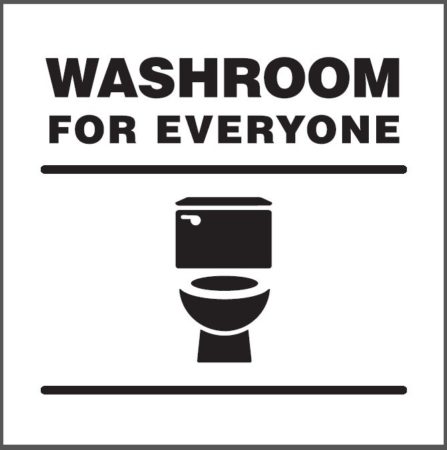RHO has designed 8 new washroom for everyone signs! Choose the one best suited to your facilities to make your building more welcoming and inclusive of trans and non-binary people. You can download the PDF and print it yourself.
Steps to Having Gender Neutral washrooms in your organization
The most user friendly type of washrooms is single user, gender neutral, accessible, and includes change tables. This type of washroom can be used by everyone and maximizes privacy.
Where single user washrooms do not exist and cannot be built, multi-stall washrooms can be converted to gender neutral facilities:
- Ensure that all doors are functional and that door locks work
- Ensure that each stall has its own sanitary disposal unit
- To increase user comfort, you may wish to consider whether partitions between stalls can be extended to increase privacy
- Urinals may be removed, they do not have to be, but privacy should be increased
- Multi-user washrooms that include many urinals and only a single stall are not ideal gender neutral facilities. In this situation consider converting it to a single user washroom or replacing urinals with one or more toilets if possible
Getting the word out
- Announce to staff, volunteers, clients and stakeholders that your facility will have gender neutral washrooms or that all washrooms are becoming gender neutral prior to the change
- Put up signs of where gender neutral washrooms are located if some facilities are gender segregated
- Train staff to refer to all washrooms options when asked
One of the principles behind universal design is that accommodations designed to benefit people with specific needs will benefit everyone in the end. Gender neutral washrooms are designed to accommodate trans, non-binary and gender questioning people, however, they also benefit children and their caregivers regardless of gender, since everyone can use the same washroom.
Bringing everyone on board
Anticipate concerns such as loss of privacy or a perceived danger in allowing men, women and children in the same confined space. Proactively anticipate and address resistance from individuals who misunderstand the intent of the change. Generally most facility users will accept a shift to single user washrooms. This is the most expensive lay out both in terms of cost and space to implement. Multi-user facilities may require an ongoing commitment to ensure everyone’s safety and comfort and may require some evaluation to fine tune what will work best for you.
Assaults and harassment do not occur more often in unisex washrooms than sex segregated ones. Disrupting sex segregation may reduce bullying behaviour. Washrooms are not more dangerous spaces than staircases, storage rooms, printing rooms or other semi-private areas, which are not sex segregated.
There are eight different versions of the sign, choose the one that reflects what is in the washroom. There are also french versions titled “Signalisation pour toilette.”

